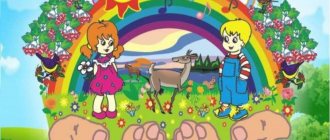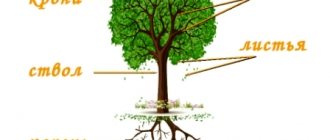Interesting Facts
For many centuries, water was considered a simple substance. In 1783, the chemist Lavoisier was able to decompose water into two substances and suggest their quantitative relationship in the molecule.
Under normal conditions, water has neither taste nor smell. The water is colorless, but when it is more than 2 meters thick it turns blue. This occurs due to the scattering of short rays of the solar spectrum.
Water is a strong absorber of solar energy. Water has a wonderful property - as it slowly heats up, it slowly cools down. The oceans of the planets accumulate heat in the summer and release it in the winter. This is how temperature fluctuations on the planet are smoothed out. Daily and seasonal temperature fluctuations decrease near water bodies. The fewer large bodies of water in a particular area, the more continental the climate there.
Water experiment for children “Drowning - not drowning”
Walk through the house in advance and prepare small objects that differ in shape and density. For example, for this study you can take toothpicks, a feather, a piece of cotton wool, a bolt, a button, a coin, decorative stones, an empty bottle, a cube, etc. Observe how each object will behave if it is thrown into a bowl of water - will it sink or not?
Before throwing something into the water, ask your child whether the item will sink. It is, of course, too early to explain to a small child the physics of the process and what density is. However, by experimenting with different objects, the child will learn to intuitively determine which one will float on the water. Operate with such concepts as heavy, light, empty, dense, etc.
We study the solid states of water. We carry “water in a sieve”
In this experiment, we will draw the child’s attention to the fact that water behaves differently in different states. Ask the young explorer if it is possible to carry away the water in a sieve. And although the child will most likely answer correctly, visually check this together - take a sieve or colander and pour water into it.
And then try to do the same with snow and ice. The child will see with his own eyes that they will remain in the sieve, and at the same time he will understand that it is possible to carry water in the sieve! Only if it is in one of its solid states.
Ask your child to state in his own words why snow and ice remain in the sieve. The baby will learn to express his thoughts and better understand the experiment itself. And you will be very interested to hear his opinion
Conclusion. In its solid state, water retains its shape and does not spread.
Simple experiments with water for children 4, 5, 6 years old at home
The child is growing, and if earlier we were primarily concerned with how to develop fine motor skills and speech, then after 4 years completely different priorities appear - now we are in a hurry to present the child with information about the world around him, about the physical properties of things, phenomena and processes. Yes, of course, teaching a child to read, count, and play logic games at this age is no less important, but this is the topic of separate articles
Here, let's figure out how to find answers to all those endless “Why?” that are increasingly coming from the mouth of a young observer
Undoubtedly, one of the best ways to introduce a child to the physical properties of things is through experiments. Only if we are now talking about simple experiments that are understandable to a preschooler, and not about those “tricks” in which everything hisses and smokes, and the child sits with round eyes from misunderstanding. No matter how beautifully the foam from mixing yeast and hydroperite spreads across the table, it is unlikely that a preschooler will be able to explain the physics of this phenomenon. Therefore, it is best to start with experiments that demonstrate to the child the phenomena and processes that he encounters in everyday life. And from those experiments, the results of which you can literally explain to your child “on your fingers.”
The simplest and most common substance that needs to be studied first is water. Here we go! Here are simple experiments with water for children at home.
Types of water
Sea water
All water is divided into categories:
- Salty (seas, oceans)
- Fresh (rivers, lakes, glaciers, groundwater)
- Rainy
- Mineral
- Human-processed water (tap, sewer, distilled, artificial)
On the planet, approximately 96.5% of the water is seawater. Fresh - much less. Its share is about 2.5%, with most of it in glaciers and groundwater. Less than 0.3% of all fresh water is found in rivers, lakes and the atmosphere, and only 0.003% is found in living organisms.
Natural waters have an important feature - transparency. It depends on how deeply the sun's rays can penetrate into the water column. Color is determined by the amount of dissolved organic compounds that color the water as it passes through the peat and humus layers of the soil.
Natural salt water contains a large number of different impurities of mineral and organic compounds. The amount of these substances affects the density of water. The densest in nature are sea and mineral waters. The water of the Dead Sea is considered the densest. Based on the degree of salinity, water is divided into several categories:
Table 1. Classification of water by salt content
| Name | Salt concentration | Where do they meet? |
| Pickles | More than 50 g/l | Dead Sea, Lake Retba, Gaetale Pond |
| With increased salinity | 10-35 g/l | Red Sea, Mediterranean Sea, World Ocean |
| Salty | 3-10 g/l | Sea of Marmara, Black Sea |
| Salty | 1-3 g/l | Sea of Azov, White Sea |
| With increased mineralization | 0.5-0.1 g/l | Mineral water Borjomi, Narzan |
Fresh water also contains salts. These are mainly calcium and magnesium. For such water there is a hardness characteristic. The higher the impurity content, the harder the water is called.
There is never pure water in nature. Water dissolves various substances well - solid, liquid and gaseous. Even rainwater, while falling to the ground, captures dust and gases from the air and dissolves them in itself.
Man changes water for his needs. The water pipes carry fresh water from rivers and reservoirs. It goes through 5 stages of cleaning and is disinfected. Water contaminated with impurities and particles from human activity enters the sewer system. Before releasing such water into the environment, the wastewater is treated at special treatment facilities.
Distilled water is used in various fields, most often in scientific and technical fields. It is obtained by evaporating and then depositing the vapor on a cold surface. Impurities remain in the distillation vessel. This water is the purest of all possible.
Fresh water is unevenly distributed on the planet. There are areas where there is a severe shortage. To solve the problem, water desalination plants are being built in such areas. At these stations, seawater is evaporated and distilled water is obtained, which is also unsuitable for human use. It is saturated with mineral salts to the level of natural fresh water.
Experience with water evaporation
After the child is convinced that heated water can turn into steam, it’s time to conduct a long-term experiment with water evaporation. Well, it’s not that it’s very long, but it will take several days
You must have done this experience yourself as a child.
So, the child pours water into a transparent glass and marks on the glass with a marker the level to which the glass is filled. After 3-4 days, it will be clearly visible that the water in the glass has noticeably decreased.
Conclusion. Water continuously evaporates from its surface at positive air temperatures (a younger child can be told that water evaporates in heat)
For older children, you can prepare not one, but two glasses with the same amount of water. Place one of them in a sunny window, and the other in the shade. This way, you can clearly show your child that at a higher temperature, water evaporates faster.
Or you can pour the same amount of water into two different containers - a glass and a saucer. And thereby make sure that evaporation will occur faster where the water has a larger surface area.
On the topic: methodological developments, presentations and notes
This summary presents a method of children's experimentation. Children's experimentation is a method of practical, purposeful action, with the help of which one's own life is formed.
It is very important to teach people, and especially children, our future generation, to be careful about water. How uncomfortable we feel when suddenly the water tap turns out to be empty! And at the same time.
METHODOLOGICAL DEVELOPMENT FOR THE PROJECT “WATER + I = friends” SYNOPSIS OF GAME-ACTIVITY WITH WATER IN THE 1ST JUNIOR GROUP ON THE TOPIC: “THE JOURNEY OF WATER”. Teacher of the 1st category of GDOU No. 72 Krasnosel.
Abstract of a joint educational activity on cognitive and research activities for children in the preparatory group for school.
Interesting activity on Experimenting with children. Note to educators.
Plan of an open lesson on the usefulness and importance of water for children 2-3 years old.
In our world we cannot do without water. She is the basis of our entire life. But besides supporting our body, water can perform many different functions, including entertainment and education.
Source
Let's explore the properties of water. Transparency
Pour water into one glass and milk into the other, put two spoons (or chopsticks, like ours) into the glasses and ask the child to explain why the spoon is visible in one glass and not in the other.
Now all that remains is to hear from the child the main conclusion of the experiment - the water is clear. Let him try to formulate this property himself, don’t tell him
Checking how oil and water interact
Let's now check how oil and water interact. Do they mix? And which one is easier?
To make the experience more clear, I recommend tinting the water, for example, with gouache. And for show, we used a pipette, mixing liquids like real scientists
After adding a little oil to the water, close the vessel with a lid and shake well. But no matter how hard we try, the oil still won’t mix with the water and will end up on top
and will spread beautifully on the surface of the colored water.
Ask your child why this happened.
The conclusion will easily come to him - oil is lighter than water .
Physical properties
Drifting ice
Water is a unique substance on the planet, capable of being in three physical states:
- Gaseous
- Liquid
- Solid
If you ask a person what water is, the most popular answer will be: “It’s a liquid.” Liquid is the most common state of water in nature.
A change in the state of water is possible due to the fact that the distance between molecules changes under the influence of temperatures. In solid form, the molecules are closest to each other. In liquid - away. In the gaseous state, it is very far away, which allows them to break away. At temperatures of 100°C and above it is steam. From 0°C to 100°C is water. And below 0°C it is ice.
When water freezes, its molecules arrange themselves into regular hexagonal shapes. All ice crystals are similar to each other. Ice has a unique property - it is lighter than the water itself from which it is obtained, and never sinks in it. Therefore, reservoirs always freeze from above, which allows life to be preserved at the bottom.
There are always tiny droplets of water in the atmosphere. But we notice the presence of moisture only when its amount increases, forming clouds and fog.





